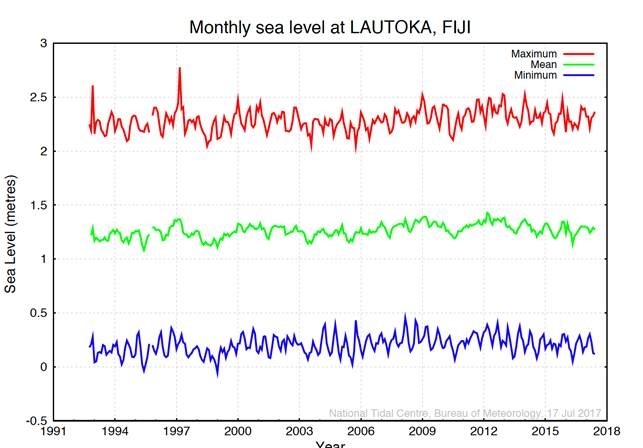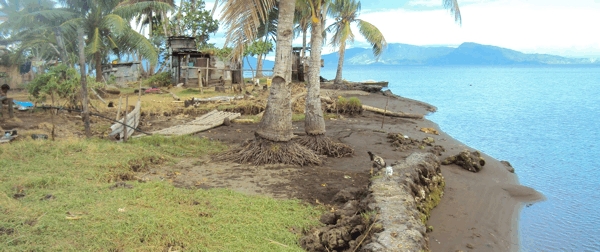h/t WUWT
• Guest post •
— by Barry Brill, Chairman of the New Zealand Climate Science Coalition
The popular press has dubbed this remote Fijian settlement the world’s first community to be forced to migrate by climate-caused rising seas. But is it true?
Natewa Bay, the largest bay in the South Pacific, is to be found in Cacaudrove province on Vanua Levu, the second-largest of Fiji’s 106 habitable islands. This long and narrow inlet funnels the ocean westwards to Vunidogoloa village, which has long been sited on the estuary of a large river at the end of the bay. The prevailing winds are easterlies.
There was a time when the villagers lived comfortably here, drawing fish from both the sea and river and tending to their plantations.
Then, about 70 years ago, the elders became concerned at the continual erosion of the foreshore, the widening of the river’s mouth, the salinisation of the soil and the surges that swept seawater through their fields during king tides. The problems became so acute that they began discussions about relocating the village to another site. But, as the Fiji Sun reports, there was just no money to begin the work at that time.
Gradual erosion
After 1956, the Vunidogoloans became resigned to living with inundation as best they could. They built a seawall, which helped for a while but then gradually sank into the encroaching sea. They moved their homes within the site and, around 1990, built a second seawall, 80 metres closer.
In 2006, the villagers finally decided they had no choice but to relocate. They petitioned the Government for assistance, and this was forthcoming a few years later. During 2010-14, all the 156 villagers were transplanted to a sheltered site some two kilometres inland.
Is Natewa Bay sinking?
It seems likely that the shores of Natewa Bay are within a subduction zone. Fiji lies in a complex tectonic setting along the boundary between the Australian Plate and the Pacific Plate. The Fiji Fracture Zone runs through Vanua Levu, which has volcanic origins and is still the site of geothermal activity.
Since 1991, the Australian Bureau of Meteorology (BoM) has operated the SEAFRAME project in the South Pacific. As set out in the project’s report for 2010-11:
“The SPSLCMP was originally developed as an Australian response to concerns raised by the member countries of the South Pacific Forum over the potential impacts of global warming on climate and sea levels in the Pacific with the principal objective of ‘the provision of an accurate long term record of sea level in the South Pacific for partner countries and the international scientific community which enables them to respond to and manage related impacts.’
The project’s sea level monitoring network consists of 12 SEAFRAME stations providing wide coverage across the Pacific Islands Forum region. The SEAFRAME stations not only measure sea level, but also observe a number of “ancillary” variables – air and water temperatures, wind speed, wind direction and atmospheric pressure.
An associated geodetic measurement program, implemented by Geosciences Australia, supports levelling surveys to first order, to determine shifts in the vertical of the sea level sensors due to local land movement, as well as continuous Global Positioning System (CGPS) stations to determine the vertical movement of the land with respect to the International Terrestrial Reference Frame.”
“Vertical movements” are an issue in the Pacific because the sites of many tide gauges are either rising or sinking. The BoM report (p. 29) sets out the “Trends in the vertical movement of the tide gauge and/or supporting structure.” Of the 12 islands, the greatest movement is in Fiji, where the trend of the long-term movement is 0.6 mm per year.
There is no tide gauge in or near Natewa Bay, and the SEAFRAME installation at Lautoka is the best available proxy. As it reveals upward movement on the western shore of Viti Levu, one would expect the eastern side of the island to be tilting downwards; and that view is supported by readings from the (sinking) local tide gauge in Suva. It seems very likely that this tilt is mirrored in Vanua Levu and Natewa Bay is also sinking.
Climate Change refugees?
Google “Vunidogoloa” and the 32,900 hits are mainly a cascade of newspaper, magazine and blog articles about the relocation of this village being the result of anthropogenic global warming (AGW). The Fijian Government has enthusiastically taken up this accusation and will use the village as a poster child as it chairs the COP23 in Bonn – with ambition to be the lead claimant for the $100 billion per year of climate ‘reparations’ that developed countries have promised in the Paris Agreement.
But is this just a cynical and opportunistic ploy by an activist media and others who stand to benefit from falsely accusing AGW?
The first thing to note is that the Google search discloses no peer-reviewed papers or data or other geological evidence regarding the Vunidogoloa site. None are mentioned in the media articles. This is a political story, not a scientific one.
There was no such thing as AGW when the village elders began planning the relocation back in 1956. That was mid-way through a long cooling period, which continued until 1979, amidst scientific concerns regarding an approaching ice age. The IPCC says AGW was not even detectable until 1958.
All the salinisation and inundation that was continuously worsening throughout the 1950s, 1960s and 1970s could only have been caused by the forces of nature and the geology of the village site. Those causes would have continued to operate until the present day. There is no need to look elsewhere.
Sea level rise
Global mean sea levels (GMSL) have risen about 18 cm (7 ins) over the past century, continuing a 10,000-year trend. Satellite measurement, which has been available since 1993, puts the rate at 3.2 mm (0.13 in) per year. While this underlying rate owes nothing to AGW, there are concerns that it will accelerate as the planet continues to warm.
The SEAFRAME tide gauge on Lautoka wharf tells us the annual average Fiji rise in relative sea level has been a steady 3.9 mm (0.15 in) over the past 25 years. At that rate, the coastal seas have risen only 9.75 cm (3.8 in) during the past quarter-century.
That microscopic change in the tide certainly hasn’t driven Vunidogoloa from its long-term home. But, conspiring with all the other forces at work, it would have contributed.
However, this particular sea level rise has been ticking away for centuries and has nothing whatever to do with AGW. The SEAFRAME data below makes it quite clear that there has been no acceleration at all in the rate of rise during the period since 19921.

Fame and fortune
The only available data strongly suggests that AGW or ‘climate change’ had nothing to do with the geological and oceanographic factors that progressively degraded the Vunidogoloa site. The village’s worldwide fame is founded on a political lie.
And famous it is. As a UK church bulletin reported:
“Every day we share our story, over and over again to people who are keen to learn about our relocation”, says village elder, Manoa Rokotovitovi. “It can be stressful to be interviewed all the time, even secondary school children come to observe the village for their school projects. But we always welcome people and want to be generous. Just as we have been blessed and give thanks to God, in turn we wish to share our blessings with others”. At this point, Manoa’s earnest expression breaks into a broad smile and he jokes that perhaps the village will soon be listed as the newest tourist attraction in Fiji.”
Fiji’s Prime Minister no doubt feels the end justifies the means. Most of us can sympathise with that, and few will begrudge a few of their tax dollars being applied to the relocation of other rural villages that sit on eroding sites. But the funding flows should be transparently named ‘Aid’ and not ‘Reparations’. It’s just the deception that sticks in my craw.
1 Despite the atmospheric concentration of greenhouse gases increasing by 20% during that 25-year period.
Views: 1545


The Fiji Sun (reference in a post below) quotes a villager:
“Our village is situated on Natewa Bay, only a few metres away from the seashore and right beside it runs a big river. So when the sea level rises the river level also rises causing the village to flood often,” he said.
That describes the issue perfectly – nothing to do with global sea level changes and all about local effects. No doubt landuse change in the catchment area has contributed. I’ve seen land elsewhere in Fiji where inappropriate cultivation methods have resulted in complete loss of soil cover, exposing rock.
Questions: Is the original village built on sand?
Do the villagers extract fresh water by pumping from a bore?
Does the bore exploit a fresh water lens perched on salt water saturated sand like many sandy atolls in the Pacific? If the answer to the last question is yes then that may lead to an answer. If the fresh water lens is not topping up to keep in pace with the rate of extraction then the land surface level may be dropping.
These fake stories in which some erosion, subsidence or notable king tides are shown as a proof-positive of the dangerous effects of anthropogenic global warming seem to be all that the MSM or the U.N. have to offer on the subject.
That should be reassuring.
If there was a real story – then they’d surely be focusing on that.
Clearly there is no real story. Seemingly not anywhere. Cause for rejoicing, then.
Open letter from Prof Nils-Axel Mörner to Fiji PM
https://wattsupwiththat.com/2017/11/13/fiji-flooding-is-fake-news-from-cop23/
Brilliant, Maggie, thanks. What a lovely letter!
On a related note, Paul Holmwood reports of a complaint against the BBC for highly misleading reporting re. sea level rise in Miami
https://notalotofpeopleknowthat.wordpress.com/2017/11/13/bbc-forced-to-withdraw-fake-sea-level-claims/